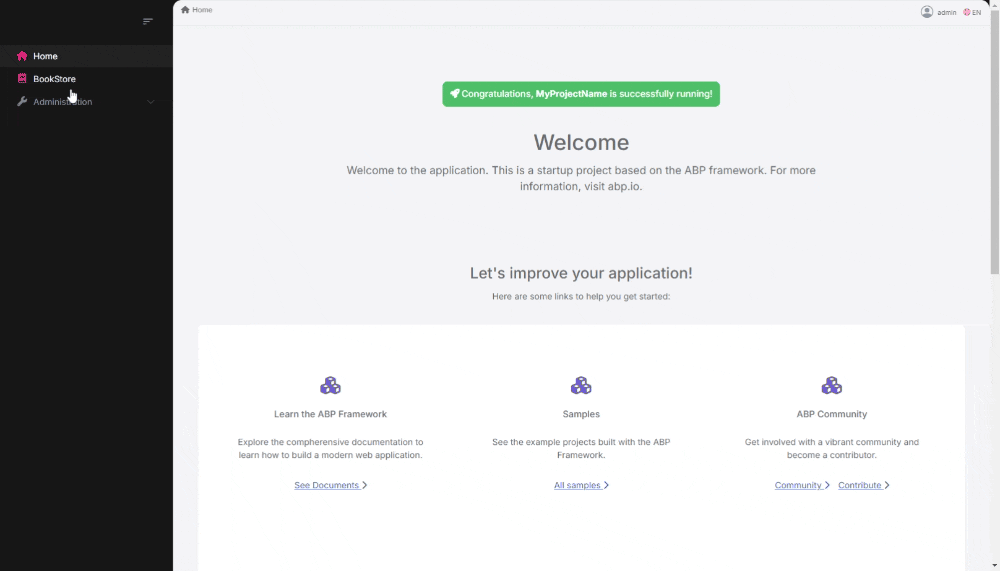Working with Lists
ListService is a utility service to provide easy pagination, sorting, and search implementation.
Getting Started
ListService is not provided in root. The reason is, this way, it will clear any subscriptions on component destroy. You may use the optional LIST_QUERY_DEBOUNCE_TIME token to adjust the debounce behavior.
import { ListService } from '@abp/ng.core';
import { BookDto } from '../models';
import { BookService } from '../services';
import { inject } from '@angular/core';
@Component({
/* class metadata here */
providers: [
// [Required]
ListService,
// [Optional]
// Provide this token if you want a different debounce time.
// Default is 300. Cannot be 0. Any value below 100 is not recommended.
{ provide: LIST_QUERY_DEBOUNCE_TIME, useValue: 500 },
],
template: `
`,
})
class BookComponent {
items: BookDto[] = [];
count = 0;
public readonly list = inject(ListService);
private bookService = inject(BookService);
constructor() {
// change ListService defaults here
this.list.maxResultCount = 20;
}
ngOnInit() {
// A function that gets query and returns an observable
const bookStreamCreator = query => this.bookService.getList(query);
this.list.hookToQuery(bookStreamCreator).subscribe(
response => {
this.items = response.items;
this.count = response.count;
// If you use OnPush change detection strategy,
// call detectChanges method of ChangeDetectorRef here.
}
); // Subscription is auto-cleared on destroy.
}
}
Noticed
listispublicandreadonly? That is because we will useListServicedirectly in the component's template. That may be considered as an anti-pattern, but it is much quicker to implement. You can always use public component members to expose theListServiceinstance instead.
Bind ListService to ngx-datatable like this:
<ngx-datatable
[rows]="items"
[count]="count"
[list]="list"
default
>
<!-- column templates here -->
</ngx-datatable>
Extending query with custom variables
You can extend the query parameter of the ListService's hookToQuery method.
Firstly, you should pass your own type to ListService as shown below:
public readonly list = inject(ListService<BooksSearchParamsDto>);
Then update the bookStreamCreator constant like following:
const bookStreamCreator = (query) => this.bookService.getList({...query, name: 'name here'});
You can also create your params object.
Define a variable like this:
booksSearchParams = {} as BooksSearchParamsDto;
Update the bookStreamCreator constant:
const bookStreamCreator = (query) => this.bookService.getList({...query, ...this.booksSearchParams});
Then you can place inputs to the HTML:
<div class="form-group">
<input
class="form control"
placeholder="Name"
(keyup.enter)="list.get()"
[(ngModel)]="booksSearchParams.name"
/>
</div>
ListService emits the hookToQuery stream when you call the this.list.get() method.
Usage with Observables
You may use observables in combination with AsyncPipe of Angular instead. Here are some possibilities:
book$ = this.list.hookToQuery(query => this.bookService.getListByInput(query));
<!-- simplified representation of the template -->
<ngx-datatable
[rows]="(book$ | async)?.items || []"
[count]="(book$ | async)?.totalCount || 0"
[list]="list"
default
>
<!-- column templates here -->
</ngx-datatable>
<!-- DO NOT WORRY, ONLY ONE REQUEST WILL BE MADE -->
Handle request status
To handle the request status ListService provides a requestStatus$ observable. This observable emits the current status of a request, which can be one of the following values: idle, loading, success or error. These statuses allow you to easily manage the UI flow based on the request's state.

import { ListService } from '@abp/ng.core';
import { AsyncPipe } from '@angular/common';
import { Component, inject } from '@angular/core';
import { BookDto, BooksService } from './books.service';
@Component({
selector: 'app-books',
templateUrl: './books.component.html',
providers: [ListService, BooksService],
imports: [AsyncPipe],
})
export class BooksComponent {
list = inject(ListService);
booksService = inject(BooksService);
items = new Array<BookDto>();
count = 0;
//It's an observable variable
requestStatus$ = this.list.requestStatus$;
ngOnInit(): void {
this.list
.hookToQuery(() => this.booksService.getList())
.subscribe(response => {
this.items = response.items;
this.count = response.totalCount;
});
}
}
<div class="card">
<div class="card-header">
@if (requestStatus$ | async; as status) {
@switch (status) {
@case ('loading') {
<div style="height: 62px">
<div class="spinner-border" role="status" id="loading">
<span class="visually-hidden">Loading...</span>
</div>
</div>
}
@case ('error') {
<h4>Error occured</h4>
}
@default {
<h4>Books</h4>
}
}
}
</div>
<table class="table">
<thead>
<tr>
<th>Id</th>
<th>Name</th>
</tr>
</thead>
<tbody>
@for (book of items; track book.id) {
<tr>
<td>{{ book.id }}</td>
<td>{{ book.name }}</td>
</tr>
}
</tbody>
</table>
</div>
How to Refresh Table on Create/Update/Delete
ListService exposes a get method to trigger a request with the current query. So, basically, whenever a create, update, or delete action resolves, you can call this.list.get(); and it will call hooked stream creator again.
this.bookService.createByInput(form.value)
.subscribe(() => {
this.list.get();
// Other subscription logic here
});
How to Implement Server-Side Search in a Table
ListService exposes a filter property that will trigger a request with the current query and the given search string. All you need to do is to bind it to an input element with two-way binding.
<!-- simplified representation -->
<input type="text" name="search" [(ngModel)]="list.filter">
ABP doesn't have a built-in filtering mechanism. You need to implement it yourself and handle the filter property in the backend.


























































